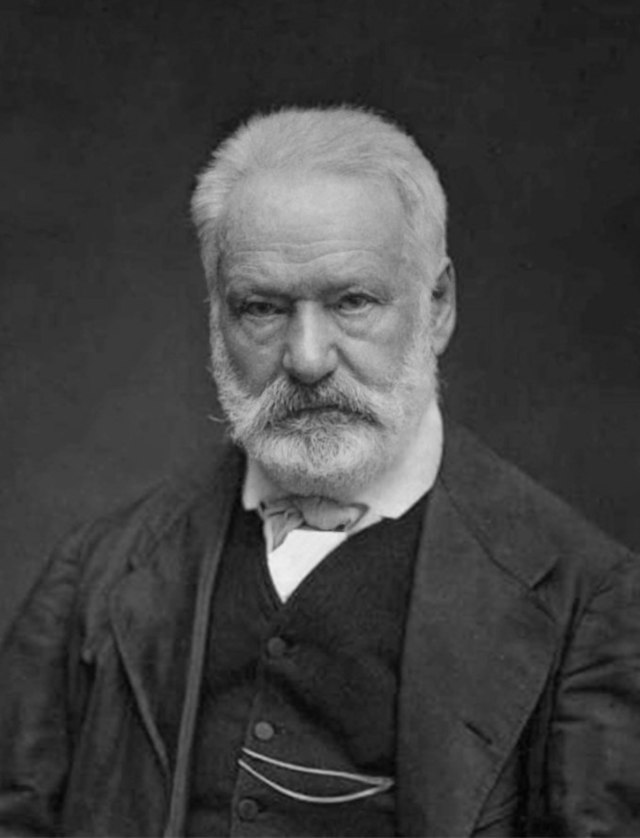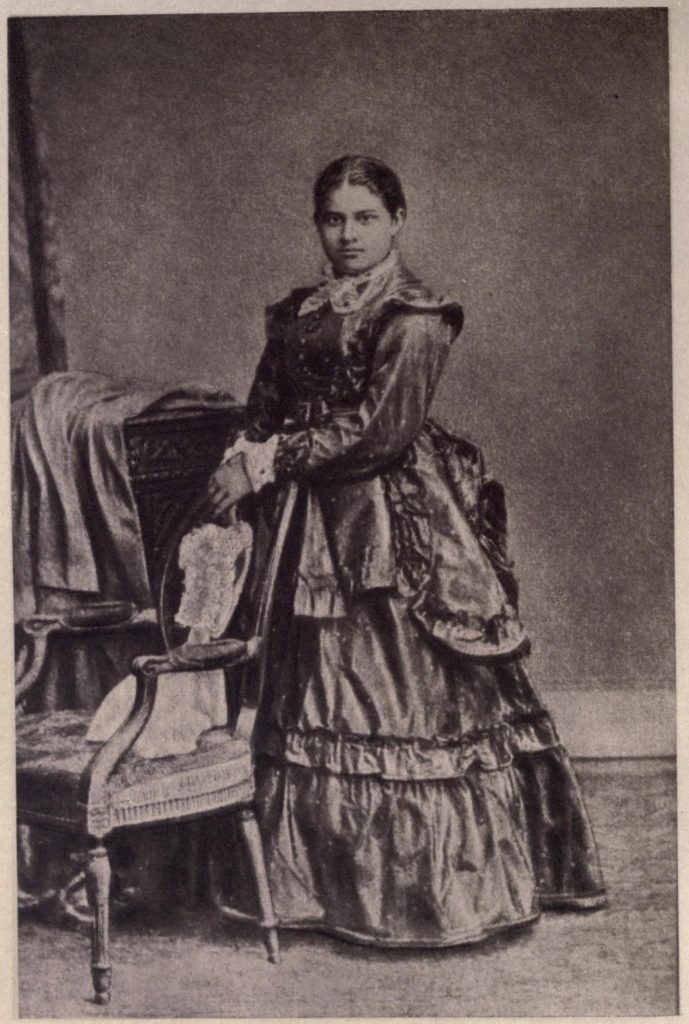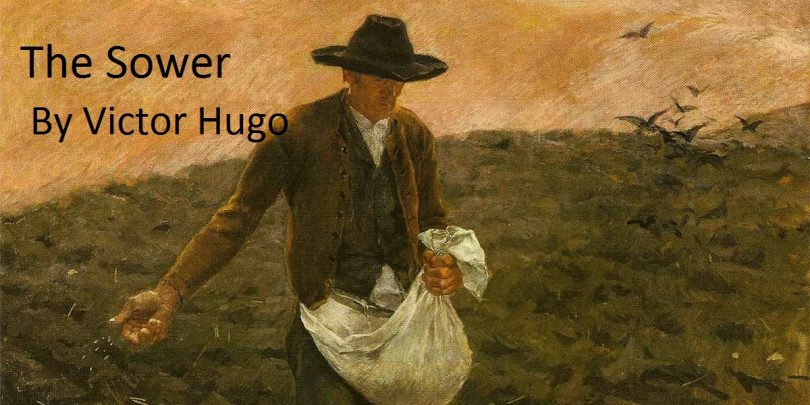About the Poet:

Victor Hugo: Poet, novelist and dramatist of the 19th century was the most important of the French Romantic writers. Though regarded in France as one of the country’s greatest poets, he is better known for novels as “Notre-Dame de Paris”(1831) and “Les Miserables”(1862

Torulata Dutt: A Bengali poet, also known as Toru, wrote in English and Fench, was born on 4th March 1856 in Kolkata. She is considered to be ‘The first Indian poetess’ to write verses in English and French. She translated dozens of poems and completed a novel before her death at the age of 21. Her poems such as ‘Seeta’, ‘Lotus’ and ‘Our Casurina Tree, are well-loved. ‘The Sower’ is a translation of Victor Hugo’s poem, Saison des Semailles: Le Soir. It is translated by Toru Dutt from French to English. ‘The Sower’ is a poem about a farmer who is sowing seeds. He has seen many bad harvests in his life. However he is so optimistic of having a good harvest every time he tosses grain.
Poem :
1
Sitting in a porchway cool,
Fades the ruddy sunlight fast,
Twilight hastens on to rule–
Working hours are well night past
2
Shadows shoot across the lands;
But one sower lingers still,
Old, in rags, he patient stands,–
Looking on, I feel a thrill.
3
Black and high his silhouette
Dominates the furrows deep!
Now to sow the task is set,
soon shall come a time to reap.
4
Marches he along the plain,
To and fro, and scatters wide
from his hands the precious grain;
Moody, I, to see him stride.
5
Darkness deepens. Gone the light.
Now his gestures to mine eyes
Are august; and strange–his height
seems to touch the starry skies.
Introduction
The poem ‘THE SOWER’ is written by the famous French writer, Victor Hugo. He is well known for his poetry, drawing, novels and also famous journalist. He is famous among the Romanic writers. Notable works of Victor Hugo are; Cromwell (1827), Herani (1830), The Hunch Back of Notre-Dame(1831), Ruy Blas, Les Miserables (1862), Toilers of the Sea(1827), He was one of the Rationalist writer among the Russian writers. He was a passionate supporter of republicanism. He was honored in many ways, including his portrait being placed in French currency. He was buried in Pantheon in Paris.
- Heartfelt elements was one of the main considerations which put Victor Hugo on the map among his peers. He proposed to manage materials from normal life in a choice of language utilized by the men. The sonnet named The Sower is one among such works. As per the writer and the interpreter of the sonnet (Toru Dutt) verse isn’t essentially a reflection of men in real life, it is the artists own sentiments while handling the creation. Sonnets emerge from the genuine circumstances that contacted the writer’s heart. The surprising utilization of scenes, along with vegetation become the significant topic of heartfelt writers.
- The Farming and the existence of a rancher is the significant subject of the sonnet and the writer portrays his affections for the rancher alongside the itemized depiction about the nature around the rancher. The artist goes straightforwardly into the depiction from the absolute first line itself.A
- 1 First Stanza:
“Sitting in a porchway……………………………working hours are well night past.”
- The poet is sitting comfortable in a porchway partaking in the dusk and rosy sky. Writer depicts the sundown sky. ‘The sundown rushes on to lead’ the line recommends the over force of the dusk sky throughout the day time since it is a period between the day and soon it will end up being the night sky. ‘Working hours are well night past’ this line recommend the hour of work in the fields are finished and the ranchers and different specialists shouldn’t be visible anyplace. Before long it will be night and dull all over.
2 Second Stanza:
“Shadow runs……………………………………… I feel a thrill”
- The dusk sky enhances the spot. An over shadows and dull pictures are spreading generally around the nature. Out of nowhere the consideration of the writer is a remaining solitary in the struck on a rancher fields. From this verse onwards the significant consideration is taken over by the rancher who is remaining solitary in the fields. ‘Old in clothes, he patient stands’ this line says regarding the old sower and his fabrics, how worn out and sloppy, yet the writer is so much excited to see his quiet and tranquil in the field.
3 Third Stanza:
“Black and high……………………………………………….a time to reap”
- Since it is a dusk time everything has all the earmarks of being blackish and rosy in variety. ‘Outline’ the term utilized by Victor Hugo in the sonnet which is an expression of French beginning, a delineated diagram loaded up with strong variety generally dark. The dark shadows of the sower is ruling the profound wrinkles in the fields. Since the sun is setting the outline steadily turns out to be increasingly big subsequently even the profound wrinkles is by all accounts little before the sower. Here the human angles is shown strong and ruling over the nature. In the following line of the sonnet Victor Hugo portrays about the outlook of the sower exhaustively ‘now to plant… … … … … ..a chance to procure’ the rancher is expecting a decent reap that should do in future since today he will plant a few seeds, later it will be watered, the seeds will develop and soon the grains will show up and every one of his desires will be satisfied. Very much like difficult work eventually brings about a productive satisfaction the rancher additionally dreams about the hour of the reap.
4 Fourth Stanza:
“Marches he along the plain…………………………to see him stride”
- The refrain manages the development of the rancher and about his activities in the field. The writer depicts the rancher as walking instead of trying to say strolling this may be a direct result of areas of strength for him and uplifting outlook towards a superior future. The rancher was isolated in the field since he was the main individual so enamored with cultivating. Very much like us when we deal with our concerns in life exclusively with mental fortitude he additionally remains solitary in the field. The rancher pushes ahead and in reverse dispersing the valuable grains which are both an image of thriving and abundance of future. The grain is called ‘valuable grains’ on the grounds that every single grain is significant in the existence of a rancher, he gathers every single one of them cautiously so he could have a reap of better yields from his fields. The writer becomes dodgy and desolate to see the sowers difficult endeavors.e
- SCATTERING SEEDS

5 Fifth Stanza:
“Darkness deepens……………………………….touch the starry skies”

The last verse closes with the portrayal of the night sky. The sundown sky continuously goes to night sky. The light is full scale and wherever the murkiness shows up. Presently the sower is imperceptible to the artist and still, at the end of the day the writer talks about the tokens of the sower which will be going on in the field since he may not return to his home. Presently the artist feels the grand and spectacular picture of the sower. The slow and moderate development of the shadow of the sower currently arrived at the highest point of the sky and the world seems, by all accounts, to be the impression of his shadow. The brilliant skies are only the impression of the seeds tossed out from the hand of the sower.
LITERARY ASPECTS OF THE POEM:
Rhyming Scheme: Rhyming words are standard rhymes consisting of the repetition, in the rhythm words of the last stressed vowel and of all the speech sounds of the following vowel.
Rhymes in the poem are; cool-rule, fast-past, lands-stands, still-thrill, silhouette-set, deep-reap, plain- grain, wide- stride, light- height, eyes- skies.
Word pictures in the poem:
Ruddy sunlight= the reddish colour of the evening sunlight.
Twilight hastens= the soft light in the sky seen after the setting of the sun, the illumination of the earth’s atmosphere by the direct rays of the sun and its reflection on the earth.
Furrow deep= the deep trench cut in the soil as when ploughed in order to plant a crop.
Starry skies= having stars visible. The night sky full of stars.
CONCLUSION:
The poem titled ‘The Sower’ written by Victor Hugo is a magnificent poem dealing with both nature and humanistic features. The words are carefully selected and have detailed description of each and every event happened in front of the poet. The poem was translated by the famous writer from India, Toru Dutt. She is well known Indian writer, this poem was translated by her. This translation is considered as most appreciated among all the other translations of the poem.
GLOSSARY:
Porchway = a covered and enclosed entrance to a building, whether taken from the interior, and forming a sort of main wall or projection without the separated roof.
Hasten = to move in a quick fashion.
Linger = to stay or remain in a place or situation
Silhouette = an illustrated outline filled in with a solid colour usually black, intended to represent the shape of an object without revealing any other visual details.
Furrow = a trench cut in the soil, as when ploughed in order to plant a crop.
Stride = to walk with long steps.
Gesture = a motion of the body especially one made to emphasize speech.
August = noble, majestic, awe inspiring.
You may also learn about:
There is Another Sky by Emily Dickinson Appreciation and Explanation








[…] You may also learn about the Poem: 2.2 The Sower by Victor Hugo. […]